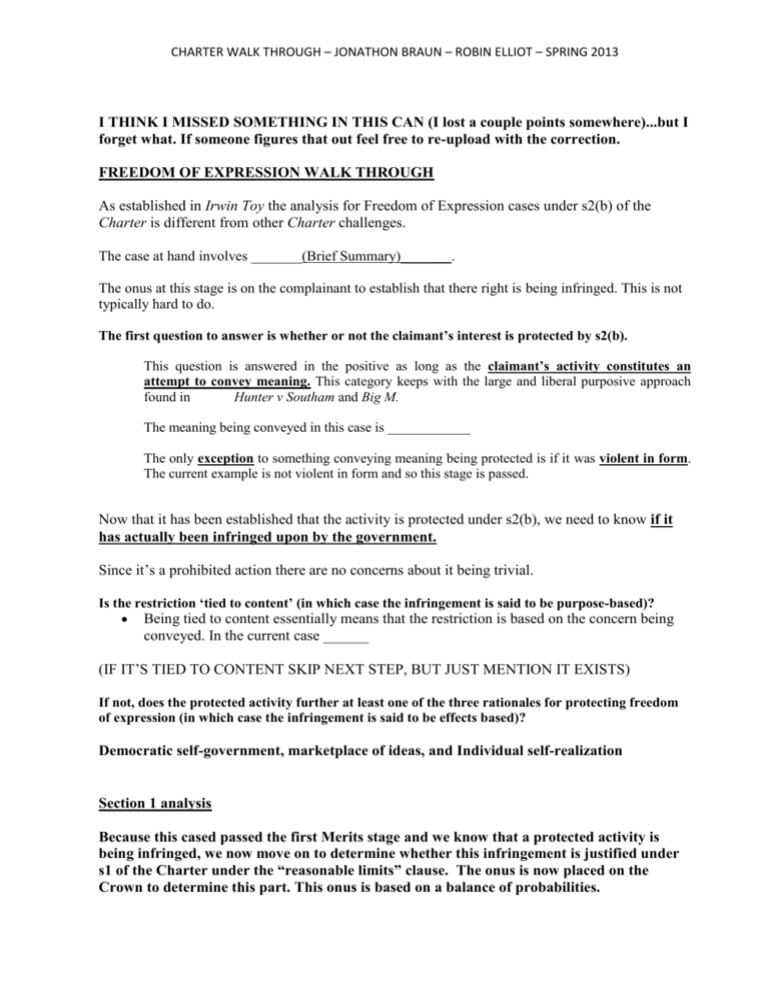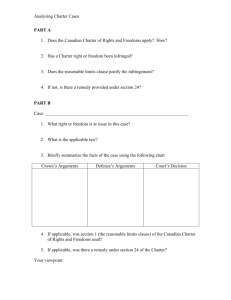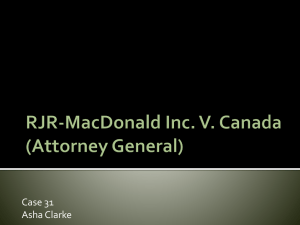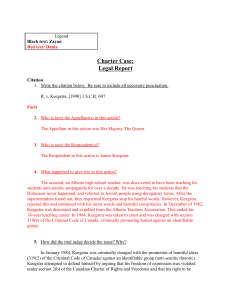- Upload a CAN
advertisement

CHARTER WALK THROUGH – JONATHON BRAUN – ROBIN ELLIOT – SPRING 2013 I THINK I MISSED SOMETHING IN THIS CAN (I lost a couple points somewhere)...but I forget what. If someone figures that out feel free to re-upload with the correction. FREEDOM OF EXPRESSION WALK THROUGH As established in Irwin Toy the analysis for Freedom of Expression cases under s2(b) of the Charter is different from other Charter challenges. The case at hand involves _______(Brief Summary)_______. The onus at this stage is on the complainant to establish that there right is being infringed. This is not typically hard to do. The first question to answer is whether or not the claimant’s interest is protected by s2(b). This question is answered in the positive as long as the claimant’s activity constitutes an attempt to convey meaning. This category keeps with the large and liberal purposive approach found in Hunter v Southam and Big M. The meaning being conveyed in this case is ____________ The only exception to something conveying meaning being protected is if it was violent in form. The current example is not violent in form and so this stage is passed. Now that it has been established that the activity is protected under s2(b), we need to know if it has actually been infringed upon by the government. Since it’s a prohibited action there are no concerns about it being trivial. Is the restriction ‘tied to content’ (in which case the infringement is said to be purpose-based)? Being tied to content essentially means that the restriction is based on the concern being conveyed. In the current case ______ (IF IT’S TIED TO CONTENT SKIP NEXT STEP, BUT JUST MENTION IT EXISTS) If not, does the protected activity further at least one of the three rationales for protecting freedom of expression (in which case the infringement is said to be effects based)? Democratic self-government, marketplace of ideas, and Individual self-realization Section 1 analysis Because this cased passed the first Merits stage and we know that a protected activity is being infringed, we now move on to determine whether this infringement is justified under s1 of the Charter under the “reasonable limits” clause. The onus is now placed on the Crown to determine this part. This onus is based on a balance of probabilities. CHARTER WALK THROUGH – JONATHON BRAUN – ROBIN ELLIOT – SPRING 2013 The first stage of this analysis asks if the infringement was “prescribed by law”. The section is rarely invoked by challengers since it is very easy for the government to surpass. If rule of law is going to deprive us of any of our rights and freedoms they can only do so on the basis of law. There has to be a law authorizing it to do so. 1. If the impugned governmental action was taken by a government official or other subordinate body, was there a legal basis for that action? The governmental action must have a basis in the law. Governmental actions must be grounded in legislation (and/or regulations) Allows for a lot of discretion. Use: Therens, Slate Communications [OR] 2. If the impugned governmental action is legislation, is that legislation reasonably/sufficiently precise in its wording? Reasonable precision of statutory language Sufficiently precise to provide the judiciary with an intelligible standard by which to do its interpretive work. Use: Irwin Toy EXAMPLES OF VALUE La Forest in RJR saw commercial expression as worthless. Dickson in Keegstra saw hate speech as worthless. In both cases McLachlin saw the expression as valuable. After determining that it is prescribed by law, the issue becomes looked at under an Oakes-type framework with a “means” and “ends” component. When looking at the following section we need to take other things into consideration. One of the main considerations is the value that the judge places on the form of expression. This can vary between the judge (see box above). Is the infringement reasonable/demonstrably justified? a. Are the objectives of the impugned government action both: i. Valid, and ii. Sufficiently important to warrant overriding the Charter right/freedom in question? Can’t be offensive to the Charter in general Saving money in financially difficult times counts. Use: NAPE Originally in Big M you were limited to the original purpose. In Butler Sopinka found the original purpose still cannot change but we may understand it differently today It is not a difficult part of the Oakes test for the government to meet and has rarely been overturned at this stage. CHARTER WALK THROUGH – JONATHON BRAUN – ROBIN ELLIOT – SPRING 2013 MEANS Are the objectives of the impugned governmental action both valid, and sufficiently important to warrant overriding the Charter right/freedom in question? Typically this is a question that passes court assessment. Butler is on a rare list of things where aspects have not passed this stage, since the imposition of sexual morality was not seen as a valid objective. In the present case the objective is to ______________________________. (HAS A SIMILAR OBJECTIVE BEEN FOUND IN ANY OTHER CASES? IF SO, MENTION THIS CASE AND SAY HOW IT WAS SEEN AS (IN)VALID). The next question to be asked is whether the impugned governmental action is proportional to the objectives underlying it. To deal with this question three questions must be asked: THIS SECTION WILL BE A LOT OF CASE ANALYSIS. REMEMBER TO CONSIDER THE VALUE OF THE CASE AND ANY OTHER FACTOR OF THOSE 7 THAT WAS MENTIONED. WE’LL PROBABLY BE GIVEN A LOT OF VARIABLES WITH WHICH TO ANALYZE THIS DISTINCITON. (i) is that action rationally connected to those objectives? A logical, rational connection will suffice. This used to be more important but now it’s easier to pass this hurdle. (ii) does that action minimally impair the right/freedom in question? - Alternative means versus over-breadth Minimal impairment can be understood in a few different ways. o Alternative means (approaching the problem in another way)...In Keegstra, the challengers say to the court that parliament has used a sledgehammer to kill a nut...shouldn’t have used Criminal Code. Should’ve used different means. Educate public not to accept those types of arguments. If you have to use legislation in addition to these means, use the Human Rights Tribunal. In Butler there are some pretty offensive ways they said to deal with the problem. Usually court says “don’t want to go there” since they don’t want to tell the government one way is better than another. (Look for other measures available listed in the fact pattern). o o - Overbreadth: Cast your net too broadly and went too far. RJR is the perfect example of this where they cut all types of advertising. They should be trying to stop all types of advertising, just advertising directed at children. Can see that very clearly in both Keegstra and Butler. In Keegstra, he actually has different headings. Complete and partial bans CHARTER WALK THROUGH – JONATHON BRAUN – ROBIN ELLIOT – SPRING 2013 o o Where judges are inclined to find that things are overbroad, they will often say that you’re going to have a harder time enforcing a complete ban, than a partial ban. RJR. However, what counts as a complete ban and a partial ban is often just a matter of semantics. (iii) do the benefits of that action outweigh the costs? - Keegstra, Butler, RJR - When judges get to this final stage, it’s important to bear in mind that when you’re measuring the costs (linked to #1). If it the expressive activity is of high value then the gov’t action is going to have high costs - Other factor to bear in mind is the severity of the restriction. Measuring the costs is a function of looking at the relative value of the expressive activity on the one hand and the severity of the sanction on the other. - Calculate those two against each other - It is a value judgment and less ‘legalistic’ than minimal impairment - The value of the infringed expressive activity becomes crucial at this stage Costs: o Nature and value of expressive activity o Nature and seriousness of restriction Benefits: o Objective of legislation o Importance of legislation CASES Irwin Toy FACTS APPLICA BILITY This case dealt with a toy company that wants to be able to advertise to children. There was legislation preventing this and so, the company challenged this legislation saying that it violated freedom of expression. There can be a rational connection even without perfect evidence Court will not, in the name of minimal impairment, take a restrictive approach to social science evidence and require legislatures to choose the least ambitious means to protect vulnerable groups (re-quoted in Butler) The framework that Irwin Toy established gave a particular context under which to deal with issues of freedom of expression. It took step one of the Merits Stage of the Analytical Framework for Charter cases and reformatted it. Keegstra FACTS Alberta high school teacher who was charged under s319(2) of CC for unlawfully promoting hatred against an identifiable group. Communicated severely anti-Semitic messaging. Supreme Court of Canada stated that the CC section did infringe upon his right to freedom of expression, but that this was justified under s1. Looks at the importance of freedom of expression, but shows how allowing hate speech does CHARTER WALK THROUGH – JONATHON BRAUN – ROBIN ELLIOT – SPRING 2013 APPLICA BILITY not necessarily further these values McLachlin talks in the case about the importance of freedom of expression. She was dissent, but this information is still useful and discusses the democracy, marketplace of ideas, and self-actualization Hate speech is not considered violence Looked at whether the amount of hate propaganda in Canada causes sufficient harm to justify legislative intervention of some type Hate speech doesn’t necessarily further the values of freedom of expression. Stopping hate propaganda is rationally connected to the objective of stopping the spread of racism For minimal impairment, it is well established that Parliament can use the criminal law to prevent the risk of serious harms Only the most intentionally extreme forms of expression will find a place within s319(2). For proportionality, we see the objective of the CC provision as extremely important Looks a lot at those three qualifiers (self-actualization, truth and knowledge, participation in democratic system) BUTLER FACTS APPLICA BILITY Operated a shop that sold and rented hard-core porn. Charged with offences contrary to obscenity provisions of s163. Objective of avoiding the harm associated with the dissemination of pornography in this case is sufficiently pressing and substantial to warrant some restriction on full exercise of the right to freedom of expression. S163(8) constitutes an infringement of s2(b) of Charter but is saved by virtue of s1 Meaning sought to be expressed need not be “redeeming” in the eyes of the court to merit the protection of s2(b) Can’t justify limiting dirt for dirt’s sake just because some community thinks that it is immoral Morality can be criminalized in some circumstances, but this was about the harm to society Unproven social science inferences can be used For minimal impairment don’t have to take a super restrictive approach RJR FACTS APPLICABILITY JTI Tobacco Products Control Act enacted by parliament prohibited advertising and promotion of tobacco products sold in Canada Although the legislation was intra vires as a legitimate exercise of Parliament’s criminal law power, its central provisions were of no force and effect as they unjustifiably infringed freedom of expression Overbreadth found in that they focused on too much and that branding Failed proportionality overbreadth CHARTER WALK THROUGH – JONATHON BRAUN – ROBIN ELLIOT – SPRING 2013 FACTS APPLICABILITY Took the reasonings in RJR to reshape the legislation Shows that a reshaping can make something pass the second time through.







